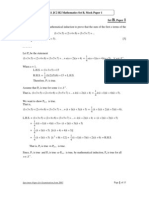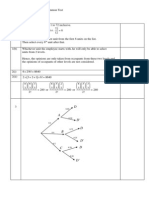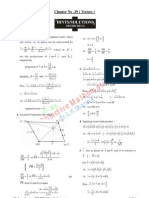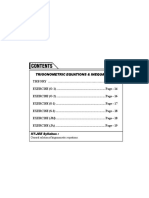Solutions To Assignment 1
Solutions To Assignment 1
Uploaded by
fkhfhfhgjCopyright:
Available Formats
Solutions To Assignment 1
Solutions To Assignment 1
Uploaded by
fkhfhfhgjOriginal Description:
Original Title
Copyright
Available Formats
Share this document
Did you find this document useful?
Is this content inappropriate?
Copyright:
Available Formats
Solutions To Assignment 1
Solutions To Assignment 1
Uploaded by
fkhfhfhgjCopyright:
Available Formats
88-224: Signals and Systems
Solutions to Assignment 1:
Problems: (B.4),(B.6),(B.7),(B.10), (B.12),(B.15).
B.4. For each proof, substitute the Cartesian form for e .
(a)
* ( ) ( )
Re( ) Re( ).
2 2
w w x jy x jy
x x jy w
+ + +
= = = + =
(b)
* ( ) ( )
Im( ) Im( ).
2 2
w w x jy x jy
y x jy w
j j
+
= = = + =
B.6. For arbitrary complex constants
1
e and
2
e ,
(a)
1 1 1 1 1 1
Re( ) Re( ( )) Re( ) jw j x jy y jx y = + = + = .
Also,
1 1 1 1
Im( ) Im( ) w x jy y = + = . Thus,
True:
1 1
Re( ) Im( ). jw w =
(b)
1 1 1 1 1 1
Im( ) Im( ( )) Im( ) jw j x jy y jx x = + = + = .
Also,
1 1
Re( ) w x = . Clearly,
True:
1 1
Im( ) Re( ). jw w =
(c)
1 2 1 2
Re( ) Re( ) w w x x + = + .
Also,
1 2 1 1 2 2 1 2
Re( ) Re( ) w w x jy x jy x x + = + + + = + .Thus,
True:
1 2 1 2
Re( ) Re( ) Re( ). w w w w + = +
(d)
1 2 1 2
Im( ) Im( ) w w y y + = + .
Also,
1 2 1 1 2 2 1 2
Im( ) Im( ) w w x jy x jy y y + = + + + = + . Thus,
True:
1 2 1 2
Im( ) Im( ) Im( ). w w w w + = +
(e)
1 2 1 2
Re( ) Re( ) w w x x = . Also,
1 2 1 1 2 2 1 2 1 2 1 2 2 1 1 2 1 2
Re( ) Re(( )( )) Re( ( )) w w x jy x jy x x y y j x y x y x x y y = + + = + + =
In general,
2 1 2 1 2 1
y y x x x x = , so False:
1 2 1 2
Re( ) Re( ) Re( ). w w w w =
Page 2 of 6
(f)
1 2 1 2
Im( ) / Im( ) / . w w y y = Also,
1 1 1 1 2 2
1 2
2 2 2 2 2 2
1 2 1 2 1 2 1 2 1 2 1 2
2 2 2 2
2 2 2 2
Im( / ) Im( ) Im( )
( )
Im( )
x jy x jy x jy
w w
x jy x jy x jy
x x y y j x y y x x y y x
x y x y
+ +
= =
+ +
+ + +
= =
+ +
In general,
2
2
2
2
2 1 2 1
2 1
/
y x
x y y x
y y
+
+
= , so False:
1 2 1 2
Im( ) / Im( ) Im( / ). w w w w =
B.7. First, express
1
w in both rectangular and polar coordinates. By inspection,
1
w = . 4 3
1 1
j jy x + = + Next, 5 4 3
2 2
1
= + = r and 927 . 0 ) arctan(
3
4
1
= = u so
1
0 . 9 2 7
1 1
5
j j
w re e
u
= = .
Second, express
2
w in both rectangular and polar coordinates. By inspections,
2
w =
785 . 0 4 /
2
2 2
2
j j j
e e e r = =
t u
. Next, 414 . 1 2 ) 4 / cos( 2 ) cos(
2 2 2
= = = = t u r x and
414 . 1 2 ) 4 / sin( 2 ) sin(
2 2 2
= = = = t u r y . Thus,
2 2 2
1.414 1.414 w x jy j = + = + .
(a) From above,
1
0.927
1 1
5
j j
w re e
u
= = .
(b) From above,
2 2 2
1.414 1.414 w x jy j = + = + .
(c)
2
2 2
1 1
5 25 w r = = = . Similarly,
2
2
2 2
4 w r = = .
(d)
1 2 1 2 1 2
( ) ( ) (3 1.414) (4 1.414) 4.414 5.414 w w x x j y y j j + = + + + = + + + = + .
(e)
1 2 1 2 1 2
( ) ( ) (3 1.414) (4 1.414) 1.586 2.586 w w x x j y y j j = + = + = + .
Converting to polar form,
033 . 3 ) 586 . 2 ( ) 585 . 1 (
2 2
= + = r
and 021 . 1 ) arctan(
586 . 1
586 . 2
= = u .
Thus,
021 . 1
2 1
033 . 3
j j
e re = =
u
e e .
(f)
1 2
1.713
1 2 1 2
10
j j j
w w re r e e
u u
= = . Converting to Cartesian form,
414 . 1 ) 713 . 1 cos( 10 = = x and 899 . 9 ) 713 . 1 sin( 10 = = y .
Page 3 of 6
Thus,
1 2
1.414 9.899 w w x jy j = + = + .
(g)
1
1 2
2
( ) 0.142 1 1 1
2 2 2
2.5
j
j j
j
w re r
e e
w r e r
u
u u
u
= = = .
B.10. (a) Note, we can rewrite ) 3 cos( ) 3 / 3 sin( 5 . 1 ) 3 cos( 5 . 2 | t + = + t c t t as
) R e ( ) 5 . 1 5 . 2 R e (
) 3 ( ) 3 / 3 ( 3 | t + +
= +
t j t j t j
ce e j e . Working with the left-hand side,
)) 5 . 1 5 . 2 ( Re( ) 5 . 1 5 . 2 Re(
) 2 / 3 / ( 3 ) 3 / 3 ( 3 t t t + +
+ = +
j t j t j t j
e e e j e .
The unknown constants c and | are determined by comparing the left- and
right-hand sides.
, 416 . 1 )) 6 / 5 sin( 5 . 1 ( )) 6 / 5 cos( 5 . 1 5 . 2 ( 5 . 1 5 . 2
2 2 ) 2 / 3 / (
= + + = + =
+
t t
t t j
e c
and
558 . 0 )
) 6 / 5 cos( 5 . 1 5 . 2
) 6 / 5 sin( 5 . 1
arctan( ) 5 . 1 5 . 2 (
) 2 / 3 / (
=
+
= + Z =
+
t
t
|
t t j
e .
(b) Note, = + = =
))) sin( ) ))(cos( sin( ) Re((cos( ) Re( ) cos(
) (
| | u u | u
| u
j j e
j
= + ) ) ) s i n ( ) c o s ( ) c o s ( ) ( s i n ( )) sin( ) sin( ) cos( ) Re((cos( | u | u | u | u j
)) sin( ) sin( ) cos( ) (cos( | u | u . Thus,
). sin( ) sin( ) cos( ) cos( ) cos( | u | u | u =
(c) Noting that
j
e e
x
x j x j
2
) sin(
o o
o
= , first solve the indefinite integral
} } }
+
=
j
e e
dx
j
e e
e dx x e
j x j x x j x j
x x
2 2
) sin(
) ( ) ( o e o e o o
e e
o
) ( ) (
) ( 2
1
) ( 2
1
o e o e
o e o e
j x j x
e
j j
e
j j
+
+
= .
Substituting the limits of integration yields
( ) ( ) ( ) ( )
1 1
sin( ) ( ) ( ).
2 ( ) 2 ( )
b
x b j j b j j
a
e x dx e e e e
j j j j
e e o o e o e o o e o
o
e o e o
+ +
=
+
}
Page 4 of 6
B.12 (a)
) 2 / 4 / 1 ( 4 / 1 ) 2 ( ) 2 ( 4
) ( 1 ) (
k j k j k j
e w e w e w
+ + +
= = = =
t t t t t
. Thus,
( 1 / 4 / 2 ) j k
w e
t +
= for [0,1, 2, 3] k = .
MATLAB code:
>> k=[0:3];
>> w=exp(j*pi*(1/4+k/2));
>> t=linspace(0,2*pi,200);
>> h=plot(real(w),imag(w),'kx',cos(t),sin(t),'k:');
>> axis equal; xlabel('Real'); ylabel('Imag'); grid;
>> set(h(1), 'makersize',20,'linewidth',2);
Figure B.12a
(b) Notice,
5 ( / 4 2 )
32
[ (1 2)] (1 ) 32
2
j k
w j j e
t t +
+ = + = .
This implies that
( / 4 2 ) 1/ 5 ( / 20 2 / 5)
(1 2) [32 ] 2
j k j k
w j e e
t t t t + +
+ = = .
Thus,
) 5 / 2 20 / (
2 ) 2 1 (
k j
e j w
t t +
+ + = for [0,1, 2, 3, 4] k = .
MATLAB code
>> k=[0:4];
>> w=(1+j*2)+2*exp(j*pi*(1/20+2*k/5));
>> t=linspace(0,2*pi,200);
>> h=plot(real(w),imag(w),'kx',1+2*cos(t),2+2*sin(t),'k:');
>> axis equal; xlabel('Real'); ylabel('Imag');grid;
Page 5 of 6
>> set(h(1), 'makersize',20,'linewidth',2);
Figure B.12b
(c) The solution set of 3 | 2 | = j w describes a circle. To see this, note that
2 * 2 2 2
| 2 | ( 2)( 2) [ ( 2)][ ( 2)] ( 2) 3 9 w j w j w j x j y x j y x y = = + = + = = .
This circle has center (0, 2) and radius r=3.
MATLAB code:
>> theta=linspace(0,2*pi,201);
>> x=3*cos(theta);
>> y=2+3*sin(theta);
>> plot(x,y,'k-');
>> axis equal; xlabel('Real'); ylabel('Imag');grid;
Figure B.12c
Page 6 of 6
(d) Graph
jt
e t t w ) 1 ( ) ( + = for 10 10 s s t .
MATLAB code:
>> t=[-10:.01:10];
>> w=(1+t).*exp(j*t);
>> im10=find(t==-10);
>> im=find(t<0);
>> i0=find(t==0);
>> ip=find(t>0);
>> ip10=find(t==10);
>> plot(real(w(im10)),imag(w(im10)),'vk',...
>> real(w(im)),imag(w(im)),'k',real(w(i0)),imag(w(i0)),'ok',...
>> real(w(ip)),imag(w(ip)),'k:',...
>> real(w(ip10)),imag(w(ip10)),'k^');
>> axis equal; xlabel('Real'); ylabel('Imag');
>> legend('t=-10','t<0','t=0','t>0','t=10',0)
Figure B.12d
B.15
for .
The two distinct solutions are:
You might also like
- Solutions Classical Dynamics of Particles and Systems 5edDocument496 pagesSolutions Classical Dynamics of Particles and Systems 5edRicardo Vega100% (8)
- Signal Detection and Estimation - Solution ManualDocument169 pagesSignal Detection and Estimation - Solution ManualSolidstate Raman64% (14)
- 569 - PR 2-2 - Dirac Particle in Uniform Magnetic FieldDocument2 pages569 - PR 2-2 - Dirac Particle in Uniform Magnetic FieldBradley NartowtNo ratings yet
- SPM Addmath 2007 AnswerDocument3 pagesSPM Addmath 2007 Answermaieqa8738% (8)
- Rvhs h2 Math p1 SolutionsDocument13 pagesRvhs h2 Math p1 SolutionsjimmytanlimlongNo ratings yet
- ACJC 2014 H2 Maths Supp Exam (Solution For Students)Document9 pagesACJC 2014 H2 Maths Supp Exam (Solution For Students)RaymondZhangNo ratings yet
- MA1505 Tutorial Solution 1Document6 pagesMA1505 Tutorial Solution 1Bilguun BatboldNo ratings yet
- Vector Calculus Cheat SheetDocument1 pageVector Calculus Cheat SheetAyisha A. GillNo ratings yet
- 2012 ACJC Prelim H2 Math SolnDocument15 pages2012 ACJC Prelim H2 Math Solnckhowh_23284524667% (3)
- AJC H2 Math 2013 Prelim P1 SolutionsDocument15 pagesAJC H2 Math 2013 Prelim P1 Solutionsnej200695No ratings yet
- EGM6341 Sol HW 01Document22 pagesEGM6341 Sol HW 01Redmond R. ShamshiriNo ratings yet
- 2008 Ext1 PDFDocument3 pages2008 Ext1 PDFBrandi RoseNo ratings yet
- Mi h2 Math Solutions p1Document10 pagesMi h2 Math Solutions p1jimmytanlimlongNo ratings yet
- AE 321 - Solution of Homework #2Document7 pagesAE 321 - Solution of Homework #2Arthur DingNo ratings yet
- Edexcel C3 June 2005 To June 2011 All Questions Mark SchemeDocument44 pagesEdexcel C3 June 2005 To June 2011 All Questions Mark SchemeOrhan AtestemurNo ratings yet
- 2007 YJC Paper 1solDocument12 pages2007 YJC Paper 1solYudi KhoNo ratings yet
- Ath em Ati CS: L.K .SH Arm ADocument8 pagesAth em Ati CS: L.K .SH Arm APremNo ratings yet
- HCI H2 Maths 2012 Prelim P1 SolutionsDocument12 pagesHCI H2 Maths 2012 Prelim P1 Solutionsnej200695No ratings yet
- BT2 Revision Package Solutions (2008 Prelims)Document111 pagesBT2 Revision Package Solutions (2008 Prelims)gerwynngNo ratings yet
- NYJC JC 2 H2 Maths 2011 Mid Year Exam Solutions Paper 1Document10 pagesNYJC JC 2 H2 Maths 2011 Mid Year Exam Solutions Paper 1jimmytanlimlongNo ratings yet
- Ath em Ati CS: L.K .SH Arm ADocument10 pagesAth em Ati CS: L.K .SH Arm ADeepak KumarNo ratings yet
- 2011 Set B Mock Paper 1 SolutionsDocument15 pages2011 Set B Mock Paper 1 SolutionsJordan TiongNo ratings yet
- Ajc h2 Math p1 SolutionsDocument15 pagesAjc h2 Math p1 SolutionsjimmytanlimlongNo ratings yet
- MJC JC 2 H2 Maths 2011 Mid Year Exam Solutions Paper 1Document22 pagesMJC JC 2 H2 Maths 2011 Mid Year Exam Solutions Paper 1jimmytanlimlongNo ratings yet
- Probability Concepts: 1.1 The Given Sets AreDocument21 pagesProbability Concepts: 1.1 The Given Sets AreSudipta GhoshNo ratings yet
- HW 1 - SolutionsDocument2 pagesHW 1 - SolutionsMahir MahmoodNo ratings yet
- Ath em Ati CS: L.K .SH Arm ADocument12 pagesAth em Ati CS: L.K .SH Arm APremNo ratings yet
- RT Solutions-22!01!2012 XIII VXY Paper I Code A SolDocument16 pagesRT Solutions-22!01!2012 XIII VXY Paper I Code A Solvishal110085No ratings yet
- AIEEE 2011 Mathematics Question PaperDocument12 pagesAIEEE 2011 Mathematics Question Papermohit24031986No ratings yet
- NJC JC 2 H2 Maths 2011 Mid Year Exam SolutionsDocument10 pagesNJC JC 2 H2 Maths 2011 Mid Year Exam SolutionsjimmytanlimlongNo ratings yet
- Ath em Ati CS: L.K .SH Arm ADocument11 pagesAth em Ati CS: L.K .SH Arm APremNo ratings yet
- Ath em Ati CS: L.K .SH Arm ADocument5 pagesAth em Ati CS: L.K .SH Arm APremNo ratings yet
- Aieee Paper 2008Document30 pagesAieee Paper 2008Ravi LorventNo ratings yet
- Resolucao 2008-2009 - s2-t2Document11 pagesResolucao 2008-2009 - s2-t2ChevronelleNo ratings yet
- CJC h2 Math p1 SolutionDocument13 pagesCJC h2 Math p1 SolutionjimmytanlimlongNo ratings yet
- HCI 2008 Promo W SolutionDocument12 pagesHCI 2008 Promo W SolutionMichael CheeNo ratings yet
- RT Solutions-22!01!2012 XIII VXY Paper II Code A SolDocument16 pagesRT Solutions-22!01!2012 XIII VXY Paper II Code A Solvishal110085No ratings yet
- Answ Er Key: Hints & Solutions (Year-2009)Document24 pagesAnsw Er Key: Hints & Solutions (Year-2009)sabhari_ramNo ratings yet
- AJC JC 2 H2 Maths 2011 Mid Year Exam Solutions Paper 1Document12 pagesAJC JC 2 H2 Maths 2011 Mid Year Exam Solutions Paper 1jimmytanlimlongNo ratings yet
- IIT JEE 2011: Mathematics Paper IIDocument9 pagesIIT JEE 2011: Mathematics Paper IIkapilNo ratings yet
- Jee 2014 Booklet3 HWT Solutions Complex NumbersDocument12 pagesJee 2014 Booklet3 HWT Solutions Complex NumbersvarunkohliinNo ratings yet
- Nyjc h2 Math p1 SolutionDocument10 pagesNyjc h2 Math p1 SolutionjimmytanlimlongNo ratings yet
- Answers Paper AIEEEDocument17 pagesAnswers Paper AIEEESuyash ChauhanNo ratings yet
- Precalculus Review: For Problems 1 Through 3, Let P (1, 3) and Q (5, - 3)Document7 pagesPrecalculus Review: For Problems 1 Through 3, Let P (1, 3) and Q (5, - 3)shannonhu519No ratings yet
- Additional Calculus Problems 2-Integration and Applications SolutionsDocument5 pagesAdditional Calculus Problems 2-Integration and Applications SolutionsNicholas TehNo ratings yet
- 2009 SRJC Paper2 SolutionsDocument24 pages2009 SRJC Paper2 SolutionsFang Wen LimNo ratings yet
- Narayana Grand Test - 8Document12 pagesNarayana Grand Test - 8Meet ShahNo ratings yet
- Solutions To Abstract Algebra: Chapter 13 - Field Theory David S. Dummit & Richard M. Foote Solutions by Positrón0802Document24 pagesSolutions To Abstract Algebra: Chapter 13 - Field Theory David S. Dummit & Richard M. Foote Solutions by Positrón0802ZQQNo ratings yet
- Acjc h2 Math p2 SolutionsDocument8 pagesAcjc h2 Math p2 SolutionsjimmytanlimlongNo ratings yet
- Ath em Ati CS: L.K .SH Arm ADocument8 pagesAth em Ati CS: L.K .SH Arm APremNo ratings yet
- Ath em Ati CS: L.K .SH Arm ADocument10 pagesAth em Ati CS: L.K .SH Arm APremNo ratings yet
- (3x) (1+ 1 3x) 1 2 3x + 1 2 (1 2 1) 2 (1 3x) + ...... ) (3x) + 1 2 (3x) 1 8 (3x) + ......Document10 pages(3x) (1+ 1 3x) 1 2 3x + 1 2 (1 2 1) 2 (1 3x) + ...... ) (3x) + 1 2 (3x) 1 8 (3x) + ......Matthew ShiaNo ratings yet
- RI H2 Maths 2013 Prelim P2 SolutionsDocument10 pagesRI H2 Maths 2013 Prelim P2 Solutionsnej200695No ratings yet
- Notes On Succesive DifferntiationDocument14 pagesNotes On Succesive DifferntiationNafi AhmedNo ratings yet
- Analytic Geometry: Graphic Solutions Using Matlab LanguageFrom EverandAnalytic Geometry: Graphic Solutions Using Matlab LanguageNo ratings yet
- Trigonometric Ratios to Transformations (Trigonometry) Mathematics E-Book For Public ExamsFrom EverandTrigonometric Ratios to Transformations (Trigonometry) Mathematics E-Book For Public ExamsRating: 5 out of 5 stars5/5 (1)
- Form 4: Chapter 10 (Solution of Triangles) SPM Practice Fully-Worked SolutionsDocument4 pagesForm 4: Chapter 10 (Solution of Triangles) SPM Practice Fully-Worked SolutionsAdleena HendryNo ratings yet
- Table of Specifications - Mathematics 9 (4 Grading) S.Y. 2018-2019Document1 pageTable of Specifications - Mathematics 9 (4 Grading) S.Y. 2018-2019Rheyshel SebucoNo ratings yet
- Study Guide Ib-Academy PDFDocument140 pagesStudy Guide Ib-Academy PDFTwenty NineteenNo ratings yet
- Detailed Lesson Plan in Mathematics (Trigonometry) : I. ObjectivesDocument7 pagesDetailed Lesson Plan in Mathematics (Trigonometry) : I. Objectivesnos rejNo ratings yet
- Analysis of Signals and Systems EE-410Document1 pageAnalysis of Signals and Systems EE-410Fernando de la CruzNo ratings yet
- Vtu Civil Syllabus Rejinpaul PDFDocument137 pagesVtu Civil Syllabus Rejinpaul PDFTabrez AhmedNo ratings yet
- Trigonometry ReviewDocument7 pagesTrigonometry ReviewJuliusNo ratings yet
- N. Antonov, M. Vygodsky, V. Nikitin, A. Sankin-Problems in Elementary Mathematics For Home Study-MIR PublishersDocument408 pagesN. Antonov, M. Vygodsky, V. Nikitin, A. Sankin-Problems in Elementary Mathematics For Home Study-MIR PublishersAirton321No ratings yet
- Polar Form of A Complex NumberDocument25 pagesPolar Form of A Complex NumberRamish SaeedNo ratings yet
- 1.4 Orthogonality of Sines and CosinesDocument1 page1.4 Orthogonality of Sines and CosinesShinaolordNo ratings yet
- On Some Integral Representation Of ζ (n) Involving Nielsen's Generalized Polylogarithms And The Related Partition Problem Xiaowei Wang - Rivoal-ZudilinDocument16 pagesOn Some Integral Representation Of ζ (n) Involving Nielsen's Generalized Polylogarithms And The Related Partition Problem Xiaowei Wang - Rivoal-ZudilinSam TaylorNo ratings yet
- SIM1003 FE1 - 2021 - 22 - Sem1Document2 pagesSIM1003 FE1 - 2021 - 22 - Sem1Min Hui LeeNo ratings yet
- Complex AnalysisDocument21 pagesComplex AnalysisAftab AlamNo ratings yet
- Chapter 4 Power SeriesDocument55 pagesChapter 4 Power SeriesThalagawali RajagopalNo ratings yet
- Trigonometric Ratios & IdentitiesDocument2 pagesTrigonometric Ratios & IdentitiesAtharv AggarwalNo ratings yet
- Department of Environmental Science & EngineeringDocument56 pagesDepartment of Environmental Science & EngineeringSafikul HossainNo ratings yet
- Math 10 Pre IBDocument2 pagesMath 10 Pre IBNexExplosiveNo ratings yet
- Es 19Document21 pagesEs 19YunNo ratings yet
- Applied Mathematics II (E4)Document2 pagesApplied Mathematics II (E4)eliyasworku2100% (1)
- 3 LogDocument6 pages3 Logboom rang0% (1)
- Maths Quiz Questions Without Ans (Class 7)Document3 pagesMaths Quiz Questions Without Ans (Class 7)Student Service CellNo ratings yet
- General Solution of Trigonometric EquationsDocument22 pagesGeneral Solution of Trigonometric EquationsHarsh GeldaNo ratings yet
- HW7 ManualDocument19 pagesHW7 ManualDmitrii GudinNo ratings yet
- Spherical BesselDocument2 pagesSpherical BesselpingNo ratings yet
- MATLAB Workshop 1 - Numbers and Arithmetic: Change Display Format, Quit MATLABDocument7 pagesMATLAB Workshop 1 - Numbers and Arithmetic: Change Display Format, Quit MATLABSelene SombraNo ratings yet
- 2016 GRADE 12 MATH TRIAL EXAM PAPER 2 WC MEMOtDocument11 pages2016 GRADE 12 MATH TRIAL EXAM PAPER 2 WC MEMOtWonder Bee NzamaNo ratings yet
- 13sheet1 Analysis Cambridge IBDocument1 page13sheet1 Analysis Cambridge IBnickthegreek142857No ratings yet
- Taylor Formula - 2 VariablesDocument4 pagesTaylor Formula - 2 VariablesKeJeNo ratings yet
- BSC MathematicsDocument26 pagesBSC MathematicsShivani Jawla0% (1)

























































































